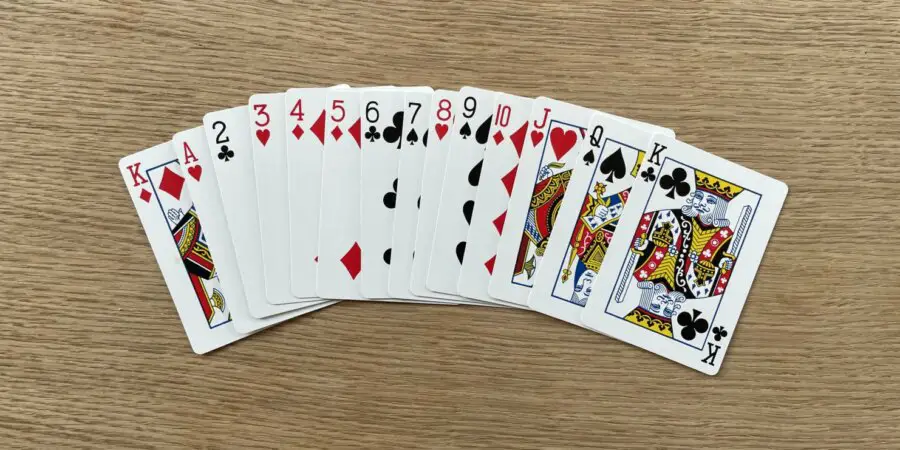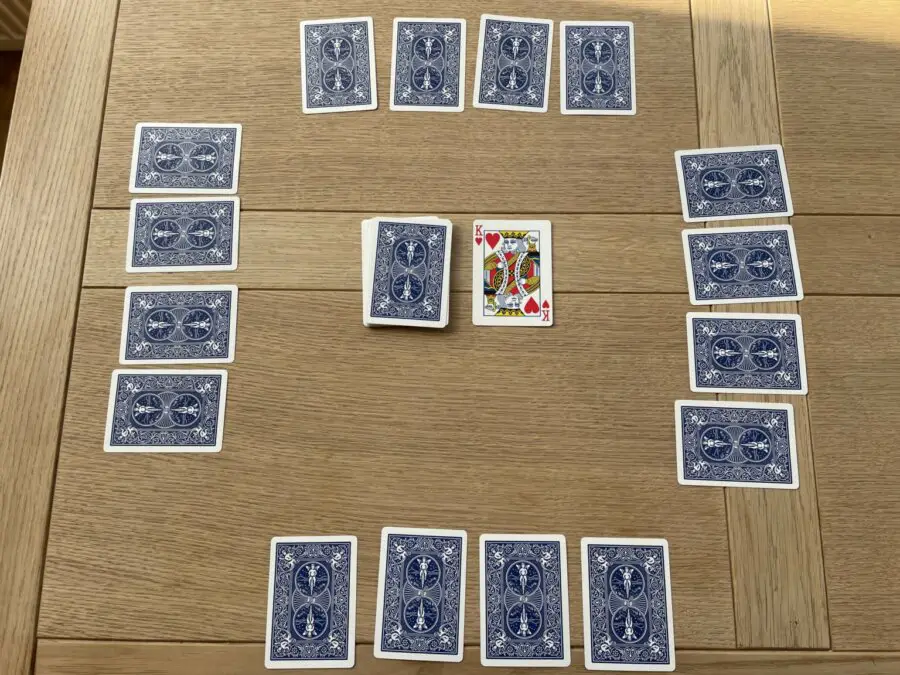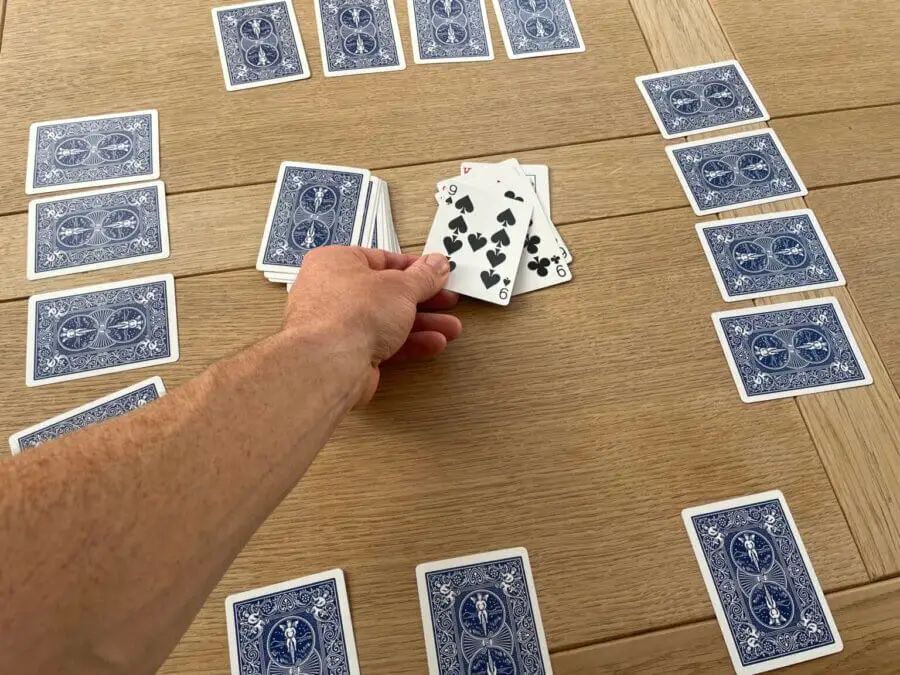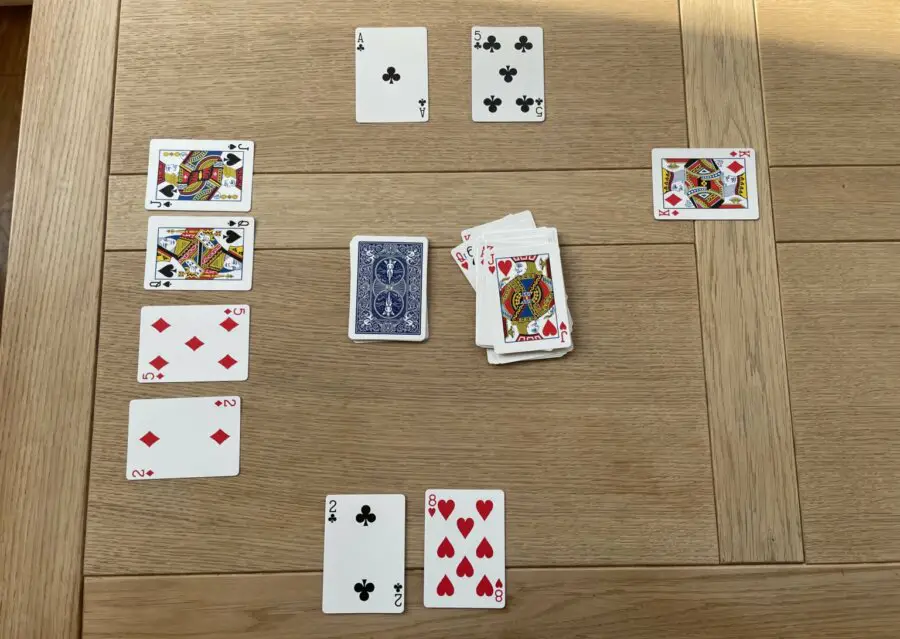Welcome to the world of Cambio, a fast-paced card game where vigilance and quick thinking are your greatest allies. Today, we’re diving into the intricacies of this entertaining game.
From the rules to gameplay strategies, this comprehensive guide will walk you through everything you need to become a master of Cambio.
This game may seem a little complex at first, but don’t worry. Our easy-to-understand guide will smoothly navigate you through the rules and strategies.
Table of Contents
Overview of Cambio
Cambio, a game of secret cards and sharp wit, can be played by 3 to 6 people with a standard 52-card deck.
The objective is to end the game with the fewest points in your hand.
The point value of each card corresponds to its face value (Ace = 1, 2 = 2…. J = 11, Q = 12) with a twist: black Kings are worth 13 points, and red Kings are a boon at NEGATIVE 2 points.

The game revolves around drawing, switching cards in your hand, using card powers, and burning cards to decrease your points.
Gameplay and Rules of Cambio
Initial Game Setup and Starting The Game
Cambio starts with the dealer, who rotates each round, dealing four face-down cards to each player. These cards remain face-down and the players will not know the value of all four cards at the beginning of the game.
Players arrange these cards in front of them in any layout they wish, but can’t move them once placed. At the start of the game, players get to peek at two of their cards, keeping their values hidden from opponents. Make sure you remember what the cards were, as you only get one chance to take a look!

The remainder of the deck is placed in the centre and the game then begins with the player left of the dealer who will draw a card to start their turn.
Drawing a Card and Making Decisions
On their turn, each player draws a card and faces a decision: discard it face-up or exchange it with one of their own cards.
If swapped, the player now knows its value, a benefit that provides strategic advantage (more on this later). The replaced card is discarded face-up.
Card Powers and How to Use Them
Cards higher than 6 possess special powers when drawn:
- 7 and 8: Allow the player to peek at one of their own cards.
- 9 and 10: Permit the player to sneak a peek at an opponent’s card.
- Jack: Enables a blind card swap between any two players.
- Queen: Grants the privilege to view any card and then swap any two cards.
Note that these powers only apply when the card is drawn, not when it’s discarded from a player’s hand.
The Art of Burning Cards
Burning cards is a quick way to lower your points. If a player knows the card on top of the discard pile matches one in their hand, they can swiftly place their matching card onto the pile, effectively “burning” it. Be quick, though! There’s only room for one burn per turn. If you’re not fast enough, you must return your card to your hand.
Burning isn’t just limited to cards in your own hand. If you know one of your opponents cards matches the card on top of the discard pile, you can burn their card and replace it with one of your own.

Here’s where things get really tricky; you can burn multiple cards at a time.
As an example, if the card on top of the discard pile is a 5 and you know that two other players each have a 5, grab both of their cards and burn them, then replace each of their cards with one of your own. In this example, the player has managed to get rid of two of their own cards!
Incorporating Penalty Cards
Penalty cards are added to the game to increase difficulty. Drawn face-down from the pile, they’re placed next to your cards and remain unknown until game end.
Players can be penalised for the following:
- Mismatched burns: A player attempts to burn a card based on matching it with a card in the discard pile, however the cards don’t match.
- Slow burns: When you attempt to burn a card but are beaten by another player.
You may also introduce other reasons for penalties as house rules.
Ending the Game (Knocking)
When a player believes they have the fewest points, they may choose to knock on the table instead of drawing a card. This locks in their hand and grants every other player one last turn.
Once back to the knocker, all players reveal their cards and each player counts their score. Points correlate with the face value of cards, except for Kings: black Kings are worth 13 points, and red Kings a desirable negative 2.

If the player who knocked does not have the fewest points, they are penalised an extra 20 points. If the knocker has the same number of points as another player, the winner is decided by whoever has the most number of cards.
The player with the fewest points wins the round. The game continues until players decide to end it. You can keep tallying points for several rounds or play to a specific number.
Cambio Card Game Strategies and Tips
To excel in Cambio, you must navigate a mix of memory skills, strategy, and a dash of audacity. Here are some tips and strategies to improve your game:
Tip #1. Master the Memory Game
Memory is a key element in Cambio. The more cards’ positions and values you remember, the better chance you have to control the game.
At the beginning of the game, try to memorize your own cards. Then, as the game progresses, make an effort to remember your opponents’ cards whenever they’re revealed.
Whilst swapping a higher number card into your own hand may seem risky and counter-intuitive, it can be a good strategy to increase the number of cards in play which you can remember. This gives you a higher chance of being able to burn a card on another players turn.
Tip #2. Be Naughty With the Jack and Queen
Whilst these special cards can give you an opportunity to swap cards in your own hand, it can also be an opportunity to mess with the other players. Why not swap cards between other players, therefore making it harder for them to remember which cards are in their hand?
Tip #3. Deceive and Mislead
Cambio isn’t just a game of memory and strategy; it’s also a game of bluffing and deception. If you draw a high value card, consider swapping it with one of your own cards even if it’s lower. Your opponents, thinking you’ve just improved your hand, might later unknowingly swap your high-value card into their hand.
Tip #4. Burn with Caution
Burning can be an effective way to lower your points, but be careful. If you attempt to burn a card and it doesn’t match the top card of the discard pile, you’ll receive a penalty card. Only burn if you’re confident about the card’s value.
Tip #5. Use the Knock Wisely
Knocking can be a game-changing move, but it’s also a high-stakes gamble. Before you knock, ensure you have a good idea of your opponents’ hands. Knocking prematurely or when you don’t have the lowest score will result in a hefty penalty of +20 points.
Remember, the lowest score a player can achieve in a round is -4 points (the player finishes the round with only the two red Kings in their hand). Keep this in mind when deciding how strong your hand is.
Variations of Cambio
Cambio is a versatile game with room for numerous variations to spice up the gameplay.
While the core rules remain the same, different playgroups can introduce their own modifications to customize the game to their preference.
- Penalties: The criteria for a penalty can be adjusted according to the group’s decision. Some groups may impose penalties for small violations like mistakenly moving a card, while others may only penalise major errors.
- Special Powers: The powers associated with cards above 6 can be altered for a change of pace. Players could invent new powers or swap the powers of different cards.
- Knocking: You could introduce a riskier variant of knocking where a player can knock at any time, not just on their turn. This could drastically alter the tempo and strategy of the game.
Frequently Asked Questions about Cambio
What happens when the draw pile runs out of cards?
If the draw pile runs out, shuffle the discard pile (excluding the top card) to create a new draw pile.
Can you burn multiple cards at once?
Yes, you can burn multiple cards at once if you’re sure about the value of cards in other players’ hands and they match the value of the card on the top of the discard pile.
What happens when I burn the wrong card?
If you attempt to burn a card but it doesn’t match the top card of the discard pile, you would receive a penalty card, which is an extra face-down card that is added to your hand.
Can I swap a card with an opponent if I have a Jack in my hand, or does it only work when I draw a Jack?
The Jack’s swapping power only applies when you draw it from the deck. You cannot use this power if the Jack is already in your hand.
Can I keep my card after using its power?
You must either discard the card you’ve drawn or swap it with one of your own. Even if you use a card’s power, you can’t keep it unless you swap it with one of your own cards.
Can I change the layout of my cards during the game?
No, once you’ve placed your cards in a certain layout at the beginning of the game, you’re not allowed to move them.
Can I choose to not use a card’s power when I draw it?
Yes, you have the option to either use a card’s power when drawn or simply discard or swap it as usual. Using a card’s power is not mandatory.
What happens if I mistakenly use a power of a card from my hand when discarded?
If a player mistakenly uses the power of a card discarded from their hand, it could be considered a rule violation and may incur a penalty based on the group’s rules.
What happens if I knock, but I don’t have the fewest points?
If a player knocks and they don’t have the fewest points, they receive an extra 20 points added to their score. It’s a high-risk, high-reward move!
How many rounds are usually played in a game of Cambio?
There’s no strict rule about the number of rounds to play in Cambio. It depends on the players’ agreement. Some might play a fixed number of rounds, while others play until they reach a certain score or until they decide to stop.
Conclusion
Cambio, with its exciting blend of strategy, memory, and quick-thinking, provides endless entertainment. Perfect for gatherings of friends or family, its unpredictable rounds keep everyone engaged.
We’ve covered the basics, but remember, practice is key to master this captivating game.
Got any unique variations, tips, or strategies? We’d love to hear from you in the comments below.
Dive into Cambio, and enjoy the thrill of the game!

Avid game player with a competitive personality. Favourite board games include Ticket to Ride, Catan, Cambio and President. Find me on Xbox Live here.
Read the About page to find more about Tiny Monkey Games.
Hi, what happens if one person tries to burn an opponents card and gets it wrong? Can that player burn it? Can another opponent try to burn? An example of this happened to me in game last night. There were four players. The player to my right believed she knew that one of my two remaining cards was the same as her discard so she tried to burn my card. She was mistaken and burnt the wrong card. Making it my turn, however she needed to take a penalty card so I didn’t drawn immediately. The player to my left took my pause as an opportunity to try and burn my other card. Since I only had two cards this does make sense strategically however is this legal? Can multiple people attempt to burn a card?
Hi Alan,
Great question!
Card(s) can be *successfully* burned once per round. If a player attempted to burn and was mistaken, then the round is still open for another player to make a successful burn.
Note I use the term “card(s)” as potentially plural, given a single burn can use multiple cards, so long as they are the same value.
In your example, the player to your left was correct to take this opportunity, however I would say that’s a risky play by them if I understand the situation correctly. Just because you only had two cards and it was revealed that one of the cards was incorrect, doesn’t automatically mean the other card is correct!
Another clarification to add here is around your card that was mistakenly burned. Whilst it’s clear that the player to your right who incorrectly burned your card should have to pick up a penalty card from the deck, the rules are open for interpretation on what happens to your card that was incorrectly burned, since all players on the table are now aware of what that card is, putting you (unfairly) at a disadvantage.
I personally discard that card from the gameplay, but that’s perhaps a rule that the whole table need to agree to, if the situation happens.
I hope that’s helpful!
Rick